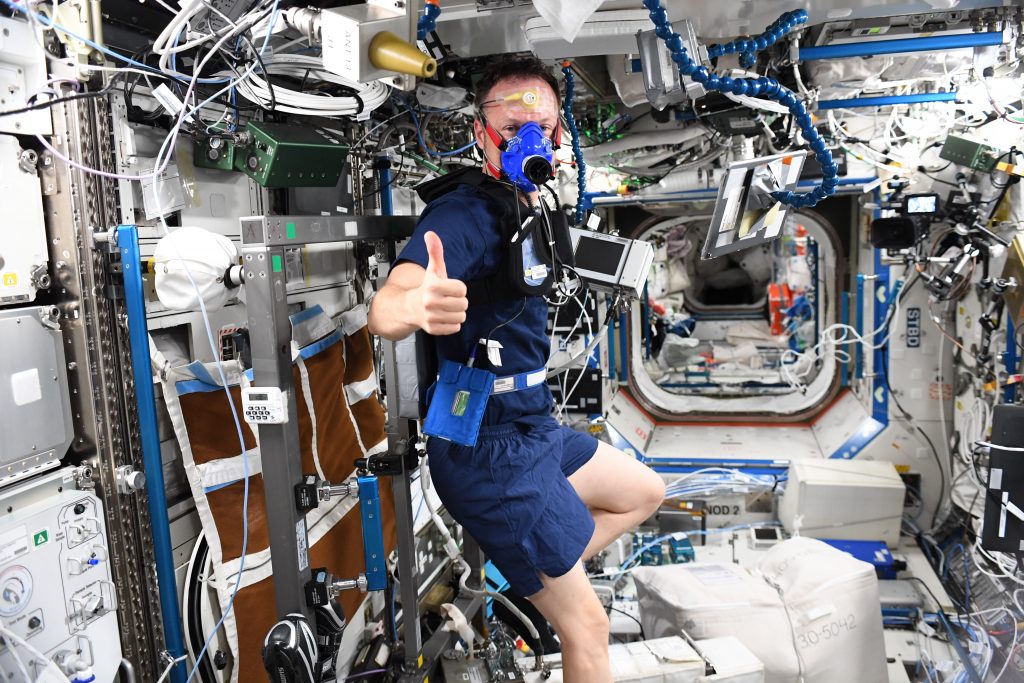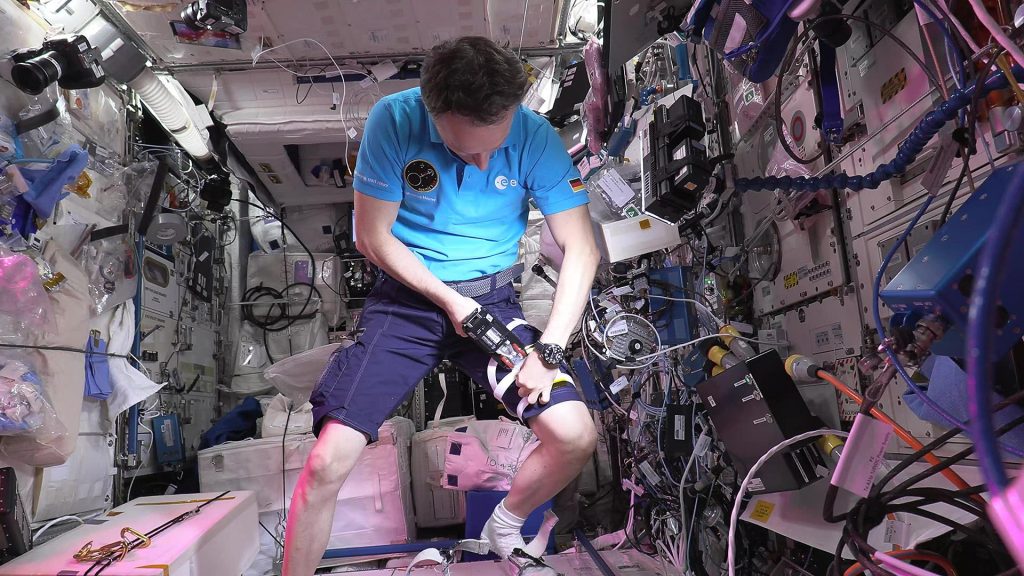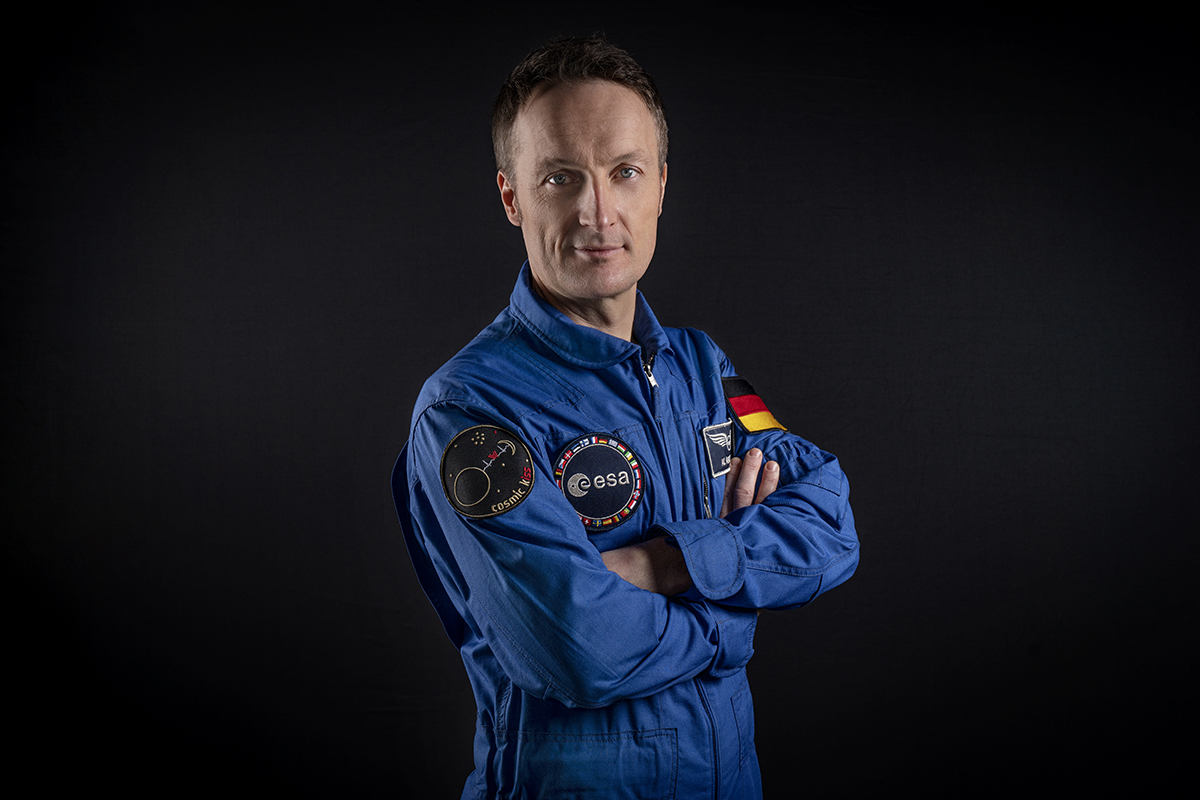The samples Matthias provided and tests he performed before lift-off serve as a baseline for in-orbit results. Many of the human research experiments Matthias is supporting require the same when he returns to Earth. This allows researchers to thoroughly analyse the impact of microgravity and better understand the effects of long-duration spaceflight on the human body.
Human research old and new
Several names might ring a bell when it comes to Matthias’s human research experiments. Not long after his arrival in orbit he ran his first session of German Space Agency DLR experiment , which you may remember from Alexander Gerst’s Horizons mission in 2018.
Using a device that looks a bit like a tricorder from Star Trek, Myotones measures the biochemical properties of muscles such as muscle tone, stiffness and elasticity during long-term spaceflight. But this time the experiment joined forces with a new DLR study, carried out under the scientific leadership of the Centre for Space Medicine at the Charité in Berlin and ESA’s European Astronaut Centre (EAC), EasyMotion.

The MyotonPRO device measures muscle tension. Credits: Cadmos
EasyMotion uses a wearable EMS device that stimulates a wearer’s muscles electrically as they exercise to optimise fitness in space. The combined inputs before, during and after flight will be used to understand the physiological strain for astronauts and could lead to new rehabilitation treatments on Earth.
Other wearables Matthias has been sporting over the past 100 days include a thermal sensor strapped to his forehead to monitor his core temperature and circadian rhythm for DLR’s Thermo-Mini experiment, a headband that monitors different sleep phases and sleep efficiency for French space agency CNES’s DREAMS and a breathing mask and two devices on his chest for DLR’s Metabolic Space. The Metabolic Space devices monitor heart rate, oxygen and carbon dioxide levels while their wearer rides on the Station’s CEVIS bike with the aim of improving cardiopulmonary diagnostics and better assessing performance in space without restricting mobility.

Matthias Maurer and Metabolic Space. Credits: ESA/NASA
A balanced diet is another vital aspect of maintaining good health in orbit. Familiar Italian space agency ASI experiment Nutrition Monitoring for the International Space Station (NutrISS) has been helping Matthias track and adjust his energy intake.
Using a special set of scales, Matthias measures his body composition and mass in zero-g. This data along with nutritional information provided via the Everywear App, developed by CNES with space medicine specialists MEDES, allows experts on the ground to monitor and provide dietary recommendations as needed.
And of course, as the eyes and ears of Europe in space, Matthias’s sight and hearing has also been in the spotlight. Matthias and his NASA crewmates Thomas Marshburn and Raja Chari all lent their eyes to Retinal Diagnostics – an ESA/DLR experiment investigating and building an AI model to diagnose changes in the optic nerve during extended stays in space. Matthias has also been testing his hearing through ASI experiment Acoustic Diagnostics. This experiment studies the effect of microgravity on an astronaut’s hearing by using headphones with a special tip that monitors the ear’s response to sound.

Matthias Maurer on the space scale. Credits: ESA/NASA
Touchy subjects
“Wash your hands thoroughly and often” has become a catch cry of the COVID-19 pandemic. This is because microorganisms are easily spread across common surfaces like door handles and light switches, and it is no less true in space.
Running in the Kubik facility – a temperature-controlled incubator for studying biological samples in Europe’s Columbus module – a DLR experiment called Biofilms has been testing the growth of bacteria such as human skin-associated bacteria Staphylococcus capitis.
Another DLR experiment, Touching Surfaces, exposes a series of five panels, made of different materials, to the indoor environment of the Space Station. Matthias and his fellow astronauts are encouraged to touch these panels frequently before they are returned to Earth for analysis.

Touching surfaces experiment. Credits: ESA–M. Maurer
Manipulating objects in microgravity
As his NASA colleagues Kayla Barron and Raja Chari supported European experiments Grip and Grasp, Matthias turned his attention to CNES’s Ultrasonic Tweezers. This experiment aims to move, manipulate and study objects or liquids without ever coming into contact with them, using the power of sound.
An acoustic tweezer uses ultrasound to trap objects. By moving the sound beam it is possible to move an object with great precision. The Ultrasonic tweezers experiment is evaluating how the technique can be used in microgravity to capture small plastic or glass marbles and move them through an obstacle course. If successful, it is expected to remain on the Space Station for use by scientists and astronauts to investigate other materials, gels and liquids and even hazardous materials or biological material without risk of contamination.
The precursor to printed skin
The DLR Bioprint First Aid experiment could eventually see astronauts print plasters from their own skin cells during missions far from Earth. However, Matthias started with fluorescent microparticles combined with two fast-curing gels.
Using a handheld bioprinter, Matthias printed plaster-like wound covering onto his foil covered limbs. These coverings will be sent back to Earth for analysis and testing, as the technology is further refined for space.

ESA astronaut Matthias Maurer uses a handheld bioprinter in space. Credits: ESA/NASA
Ageing spacefully
Back to the Kubik minilab, following a fresh delivery of pre-Christmas science, Matthias sorted synthetic muscle cells the size of a grain of rice for incubation at 37°C. Some of these cells were electrically stimulated to trigger contractions in weightlessness, while others were subjected to artificial gravity via centrifugation for a UK Space Agency experiment called Microage.
The cells returned to Earth for analysis on Cargo Dragon 24 and the insights this experiment provides could one day help people better maintain their strength and mobility into old age as researchers enhance their understanding of how muscle deteriorates.
Concrete results
Matthias has been living up to his surname (Maurer translates to mason or bricklayer in English) by stirring up concrete samples in space.
The DLR MASON/Concrete Hardening experiment seeks to understand how various concrete mixtures made of cement and sand or simulated Moon dust combined with water and various admixtures harden in microgravity. These findings will aid development of new, improved concrete mixtures for building habitats on the Moon, Mars and sustainable housing on Earth.
Phew! That’s a lot of space science, but we’re only just scratching the surface. Stay tuned for more highlights throughout Matthias’s mission on Twitter, Facebook, Instagram, YouTube the Cosmic Kiss mission page and in regular Space Station updates from ESA.



